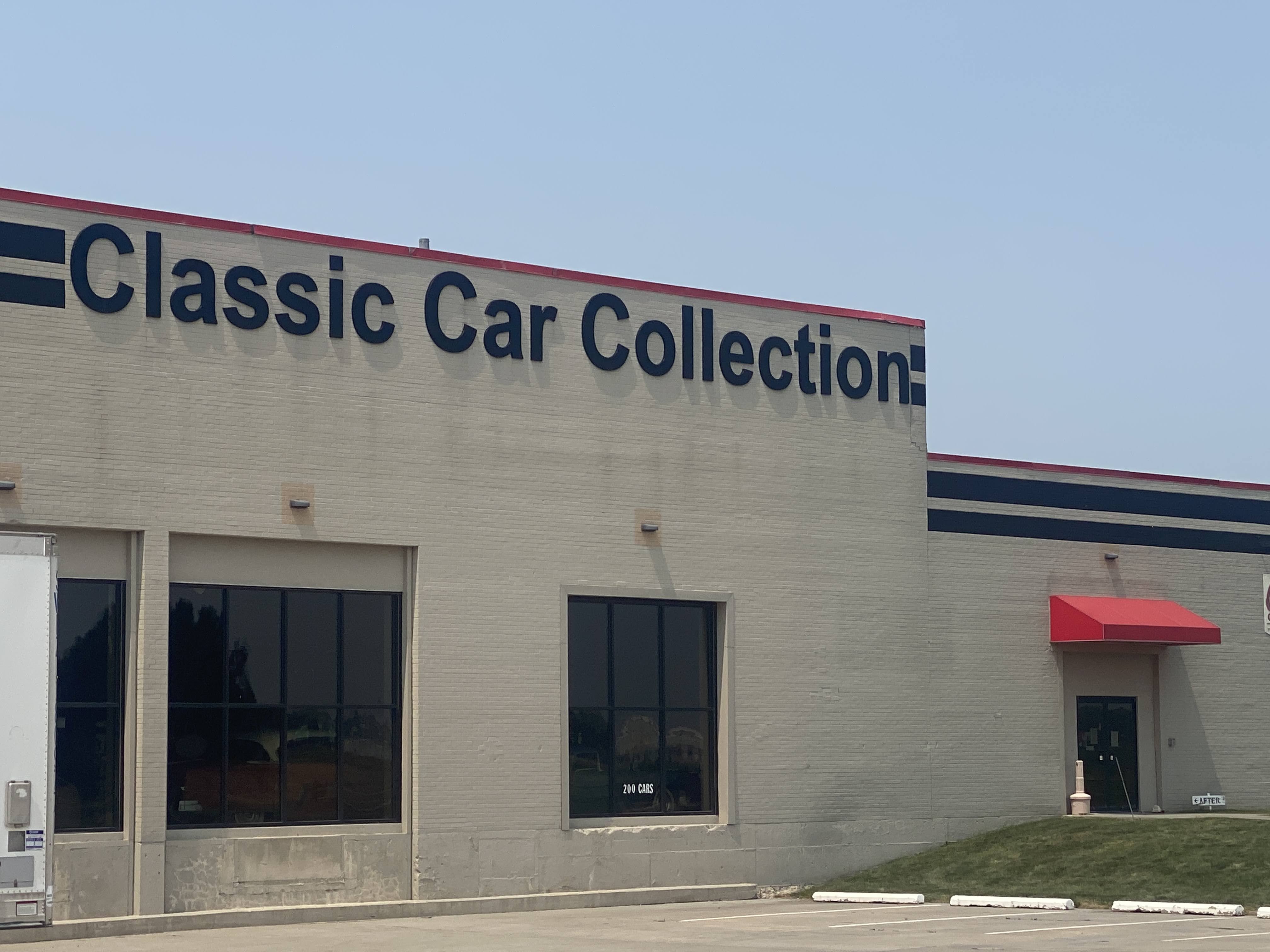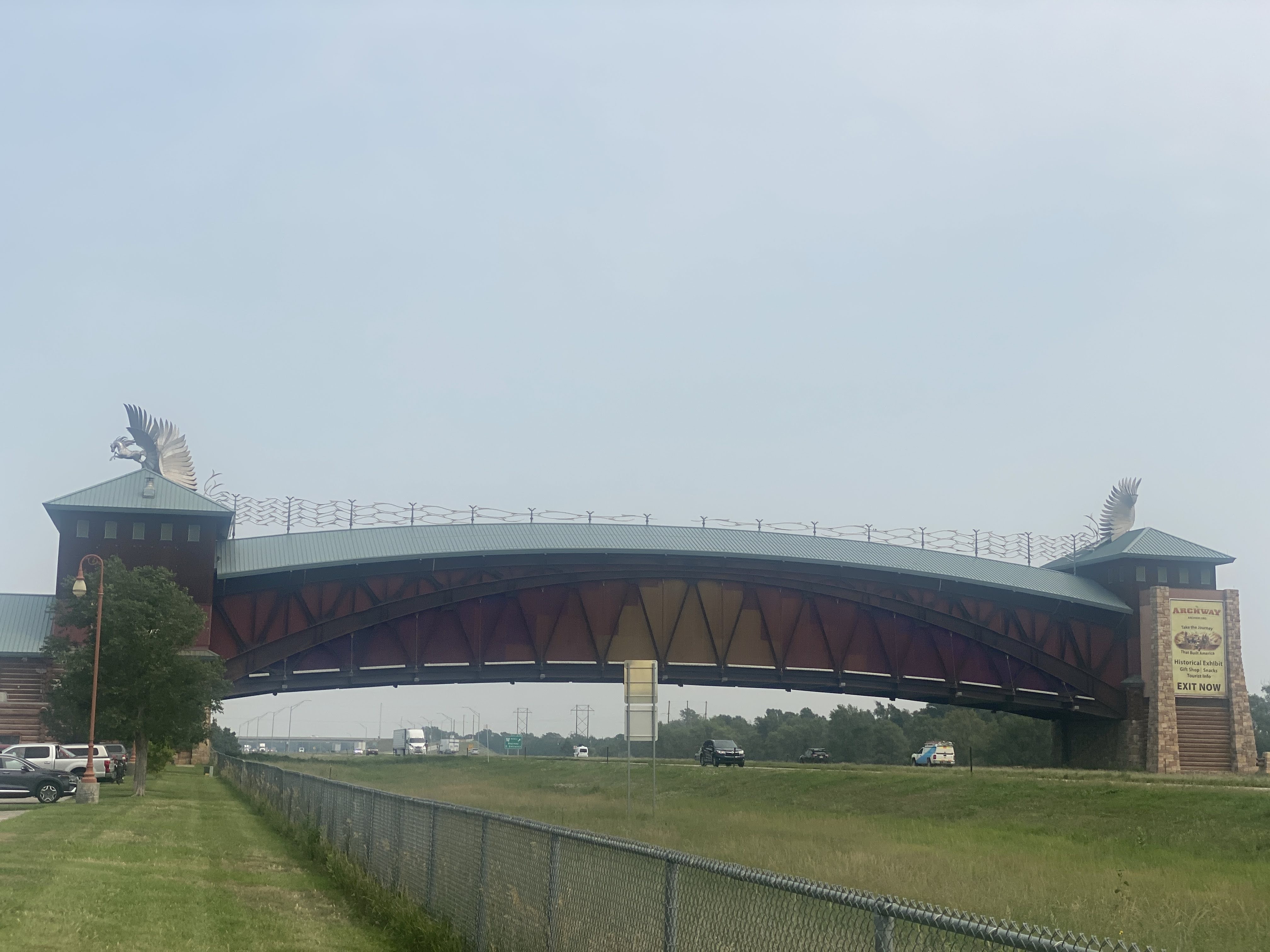Another travel day. We went only about 150 miles, but there were many interesting stops along the way…
But first, we enjoyed the Nebraska scenery…





We were told by our caravan manual to stop off and see The Golden Spike. Well, the only golden spike that I knew of was at Promontory Point, Utah, where the Central Pacific and Union Pacific Railroads completed the transcontinental railroad. So we had no idea what to expect here. Our GPS took us on a wild goose chase around and through several residential neighborhoods until we finally arrived near the railroad tracks. We figured we were getting close. Then we saw the tower:
We figured this was probably worth a stop. We had no idea!
This is The Bailey Classification Yard! We learned a little history:
During the construction of the transcontinental railroad, North Platte was platted as a railroad town by Union Pacific’s Chief Engineer Grenville Dodge. It was chosen because of its close proximity to good water and its distance from Grand Island, Nebraska. In 1866 the first train rolled through what was known at the time as “Hell on Wheels” town. General Dodge quickly moved to construct major shop facilities and winter quarters and by 1867, main line operations began. Just two years later on May 10th, East met West at Promontory Summit in Utah, 690 miles east Sacramento and 1,087 miles west of Omaha. The railroad crossed two-thirds of the continent over some of the most difficult terrain on earth. It was called, “The Work of Giants” and it was the end of the frontier, as we knew it.
Today Bailey Yard, named for former Union Pacific president Edd H. Bailey, is the world’s largest train classification yard in the world. Over 3,000 cars are classified (or sorted) to make sure the cargo reaches its final destination. The yard is eight miles long, 1 1/2 miles wide, and at its widest point contains 320 sets or railroad tracks. The yard is located in the midst of key east-west and north-south corridors, on the busiest freight rail line in America, making it a critical component of Union Pacific’s rail network.
Bailey Yard has 17 receiving and 16 departure tracks handling 14,000 rail cars every 24 hours. The railroad cars are sorted daily in the yard’s eastward and westward yards, nicknamed “hump” yards. Using a mound cresting 34 feet for eastbound trains and 20 feet for those heading west, the hump yards allow four cars a minute to roll gently into any of 114 “bowl” tracks. Here they become part of trains headed for destinations in the East, West and Gulf Coasts of America, as well as the Canadian and Mexican borders. An average of 139 trains per day are comprised of raw and finished goods, such as automobiles, coal, grain, corn, sugar, chemicals, and steel along with consumer goods, including electronics, apparel and other retail products.
To keep America moving forward, the train operations and repair shops at Bailey Yard are open 24 hours a day, seven days a week. The fueling and service center processes more than 8,500 locomotives each month, using technology like overhead cranes and elevated work bays to maintain fluid operations.
All train movement throughout Bailey Yard is handled through the on-site command center with the latest computerized control systems. The Bailey Yard command center is tied to the Harriman Dispatching Center in Omaha, which controls hundreds of intercity trains daily throughout the company’s 23-state rail system. The Bailey Yard has over 2,500 employees, working 24 hours per day…
So we stopped to take a look… More trains than you can keep track of!



At the observation deck atop the tower we could see the operations, including the hump yards, as the incoming trains are broken up and re-combined into the various outgoing trains.








It was a fascinating opportunity to see how trains really work! We loved it!
We could even see some of our friends parked next to us down below…

So after this exhilarating tour we headed off to the Lincoln County Historical Museum. It was similar to other small county museums…
This one had a rare two story log cabin…



This barbershop was built in 1900…

Typical mercantile building you would see on Main Street in the 1890s…

Then we walked the 1/2 mile to see Scout’s Rest Ranch…

Scout’s Rest Ranch was Buffalo Bill’s retreat and retirement home. He lived here when not traveling with his Wild West shows, and then again after the shows were over…
William Frederick “Buffalo Bill” Cody (February 26, 1846 – January 10, 1917) was an American soldier, bison hunter, and showman. He was born in Le Claire, Iowa Territory (now the state of Iowa), but he lived for several years in his father’s hometown in modern-day Mississauga, Ontario, Canada, before the family returned to the Midwest and settled in the Kansas Territory (now the state of Nebraska).
Buffalo Bill started working at the age of eleven, after his father’s death, and became a rider for the Pony Express at age 15. During the American Civil War, he served the Union from 1863 to the end of the war in 1865. Later he served as a civilian scout for the US Army during the Indian Wars, receiving the Medal of Honor in 1872.
One of the most famous and well-known figures of the American Old West, Buffalo Bill’s legend began to spread when he was only 23. Shortly thereafter he started performing in shows that displayed cowboy themes and episodes from the frontier and Indian Wars. He founded Buffalo Bill’s Wild West in 1883, taking his large company on tours in the United States and, beginning in 1887, in Great Britain and continental Europe.
This is his house at the Scout’s Rest Ranch. It was built in the late 1880s. It is considered to be in the “Second Empire” style, with elements of Italianate and Eastlake detailing. In my opinion, it is a big mess… Look at the shutters. Why were shutters added to the windows? Either to keep the Indians out (not applicable here) or to keep the sun off and to insulate against the cold in winter. Look at these shutters: The cannot do either: they don’t even cover the entire window if they were to be closed… I hate phony stuff like this!


Inside the decoration is “authentic Victorian”… I hate Victorian interiors! It hurts my eyes! That wallpaper is abominable!




The outbuildings were interesting…
The Ice House:

The Spring House: (It would also make a good wine cellar…)

The Cob House: Corn cobs were stored here to burn in the stoves in the house…

Lakes are always nice:

So we set off again, heading west to Ogallala…

We arrived at the RV Park and we were soon set up…



We had our last GAM.
This afternoon as we crossed over to the western-most counties of Nebraska we moved from Central time to Mountain time. But our phones, watches, and the truck GPS have a hard time handling the change. So our clocks have been flipping back and forth between the two zones; we never know what time it is…
An enjoyable time was had by all…





























